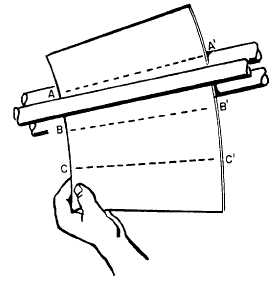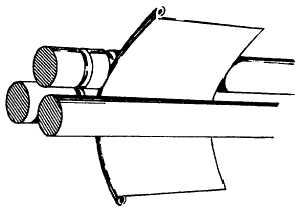[ Back ] [ Home ] [ Up ] [ Next ]
Bending on a Bar Folder
The bar folder may be used to bend and
fold metal in a number of different shapes, as illustrated in figure 13-37. This
machine has two adjustments: one for regulating the width of the fold and the
other to provide sharp or rounded bends. To operate the bar folder,
adjust the thumbscrew to the specified width of
the fold. Then turn the adjusting knob on the back of
the machine for the desired sharpness of the bend. Insert
the metal under the folding blade until it rests against
the stops. Hold the metal firmly in place with one
hand, grasp the handle with the other, and pull forward
until the desired fold is made.

Figure 13-37.-Types of bends made on
a bar folder.
FORMING SHEET METAL
A sheet metal object made on a brake
will have corners (bends) and sides
(flanges). On a forming machine, it
is possible to make an objectwithout sides. For example, you can make a circular
object such as a funnel. The forming machines
used in the Navy are usually located at aircraft
intermediate maintenance departments (AIMDs).
The two most common machines are the
slip roll and the rotary.
Slip-Roll Forming
Sheet metal can be formed into cylindrical or conical
shapes through the use of the slip-roll forming
machine. Prior to using this machine, you should
consult the manufacturers manual of operation.
To form a cylinder in the machine, you should use the
following procedures and refer to figure 13-38:
1. Adjust the front rolls so they will grip the sheet
properly.
2. Adjust the rear roll to a height that is less than enough
to form the desired radius of the cylinder.
3. Ensure that all three rolls are parallel. (The same
space exists between any two rollers at each end of
the rollers.)
4. Start the sheet into the space between the two front
rolls. As soon as the front rolls have gripped the sheet,
raise the free end of the sheet slightly.
5. Pass the entire sheet through the rolls. This forms
part of the curve required for the cylinder.
6. Set the rear roll higher to form a shorter radius.





Figure 13-38.-Forming a cylinder.

Figure 13-39-Rolling a conical
shape.

Figure 13-40.Rolling a wired edge.
7. Turn the partially formed sheet end over end, and
again pass it through the rolls.
8. Continue turning the sheet end over end and passing
it through the rolls, each time adjusting the rear
roll for a new radius, until a cylindrical shape has been
formed.
9. Remove the cylinder from the machine. The top
front roll has a quick-releasing device on one end.
This allows the released end of the roll to be raised and
the newly formed cylinder slipped off just as you would
slip a ring from your finger. Conical
shapes can be formed by setting the back roll
at an angle before running the sheet through it, or they
can be made with the rolls parallel. See figure
13-39. To make a cone with the rolls parallel, the
sheet must be fed through the rolls in such a manner
that the element lines (A-A, B-B, etc., in the illustration)
pass over the rear roll in a line parallel to the
roll. This involves slipping the large end of the cone
through the rolls at a slightly faster rate than the rate
at which the small end is being rolled through.
The grooves at the ends of the rolls can be used to form
circles of wire or rod. They can also be used to roll
wired edges, as shown in figure 13-40.
|

